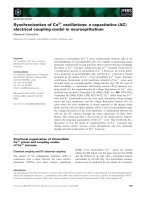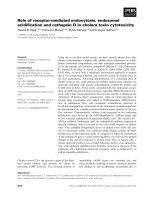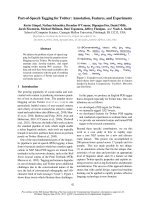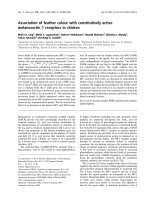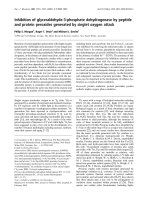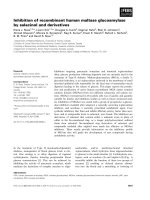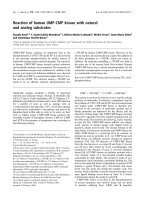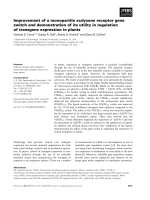Báo cáo khoa học: "Change of Diurnal Heart Rate Patterns During Pregnancy and Lactation in Dogs (Canis familiaris)" potx
Bạn đang xem bản rút gọn của tài liệu. Xem và tải ngay bản đầy đủ của tài liệu tại đây (89.22 KB, 6 trang )
Olsson K, Lagerstedt A-S, Bergström A, Häggström J: Change of diurnal heart
rate patterns during pregnancy and lactation in dogs (canis familiaris). Acta vet.
scand. 2003, 44, 105-110. – Pregnancy and lactation involve great demands on the car-
diovascular system. The purpose of this study was to investigate how the heart rate and
diurnal heart rate pattern change when dogs become pregnant or lactate. Five clinically
healthy female beagle dogs were mated, and delivered three to seven healthy puppies.
The heart rate was investigated with 24-h ECG (Holter) once during anoestrus, at 3, 5,
7 and 9 weeks of pregnancy, and at week 4 postpartum (lactation). However, at 9 weeks,
the ECG could not be recorded for the fully 24 h in 4 of 5 dogs, because labour started
and the dogs then appeared disturbed by the recordings. The results at this date are not
included in the statistical comparison. The heart rate increased progressively during
pregnancy and was still elevated at 4 weeks of lactation. During late pregnancy the dif-
ference in heart rates between daytime and nighttime became smaller, but the heart rate
was significantly higher in daytime in all periods. In conclusion, the increased heart
rates during pregnancy and lactation reflect increased demands on the cardiovascular
system and may be important to consider in clinical practice.
dog; pregnancy
Acta vet. scand. 2003, 44, 105-110.
Acta vet. scand. vol. 44 no. 3-4, 2003
Change of Diurnal Heart Rate Patterns During
Pregnancy and Lactation in Dogs (Canis familiaris)
By K. Olsson
1
, A S. Lagerstedt
2
, A. Bergström
2
and J. Häggström
1,2
1
Department of Anatomy and Physiology and
2
Department of Small Animal Clinical Sciences, Faculty of
Veterinary Medicine, Swedish University of Agricultural Sciences, Uppsala, Sweden.
Introduction
Heart rate changes in response to both external
and internal stimuli, but diurnal variations dur-
ing the reproductive cycle appear not to have
been studied in dogs. During pregnancy extra
blood is needed to meet the demands of the
feto-placental unit, leading to an increased
blood volume and increased cardiac output.
The rise in cardiac output is predominantly due
to an increase in heart rate or in stroke volume
or a combination of both. For example, in the
guinea pig the increase has been found to be
due to increased stroke volume (Hart et al.
1985, Peeters et al. 1980), but in ruminants
there is predominantly an increase in heart rate
(Olsson et al. 1998). Elevated cardiac output
has been reported in late pregnant dogs (Moore
& Reeves 1980), but the authors gave no details
of heart rate and stroke volume. Wegner &
Dröge (1975) reported that the heart rate, mea-
sured by auscultation, was increased during the
last 3 weeks of pregnancy in dachshunds.
Beagle dogs reach peak lactation 3 to 4 weeks
after parturition, when they produce a daily
milk volume of 14% to 17% of their body mass
with a comparatively high energy content (Of-
tedal 1984). Thus, lactation also involves a con-
siderable strain on the cardiovascular system in
the dog, but lactating dachhunds showed no in-
crease in heart rate (Wegner & Dröge 1975).
The purpose of this study was to investigate
how the diurnal heart rate changes in relation to
reproductive period in the female dog. We de-
cided to follow the same dogs with ambulatory
ECG (Holter) recordings for 24 h at pre-deter-
mined intervals during anoestrus, pregnancy
and lactation. Such recordings would give im-
portant information to use in the clinic when
evaluating the cardiovascular system of a preg-
nant or lactating dog.
Materials and Methods
Animals
The study sample comprised 5 clinically
healthy female beagles (Table 1). They were
born and housed at the Department of Small
Animal Clinical Sciences, Swedish University
of Agricultural Sciences, Uppsala. Dogs nos. 2
and 3 were sisters, dog no. 5 had the same
mother as these 2, and dog no. 4 was the daugh-
ter of dog no. 2 (Table 1). They lived together
until shortly before parturition and had outdoor
exercise every day. Food (Pedigree Advanced
Adult Formula
®
and Pedigree Pal
®
, Waltham,
UK) was provided daily between 6:45 a.m. and
8:00 a.m. Water was freely available. The dogs
were mated one to 3 times, and pregnancy was
confirmed by ultrasound examinations. When
parturition was close, the dog in question was
moved to an adjacent room and given access to
a whelping box. The dogs delivered between 3
to 7 puppies (Table 1). From the age of 3-4
weeks, the puppies were given food (Pedigree
Advanced Adult Formula
®
, Pedigree Pal
®
and
Pedigree Pal Advanced Formula Puppy Milk
®
,
Waltham), and they were weaned at the age of 8
weeks. The technicians had taken care of the
dogs already before the study began and were
well known to the dogs. The care of the animals
and the experimental design were approved by
the Local Ethical Committee in Uppsala, Swe-
den.
Heart rate recordings
Long-term ambulatory ECG (Holter) record-
ings took place over 24 h, once during
anoestrus, once at 3, 5, 7 and 9 weeks of preg-
nancy, and once during lactation (4 weeks post-
partum). The recordings were done according
to a method described previously (Calvert et al.
2000). Electrodes (Silver Trace AG/AgCl Elec-
trodes, No 900703-130, GE Marquette Medical
Systems, Milwaukee, WI, USA) were hidden
inside a jacket designed to fit the dogs and
firmly attached to the thorax. Holter recordings
were performed with cassette recorders (8.500
Holter recorder, GE Marquette Medical Sys-
tems) placed inside the jacket pocket. The tapes
were analysed by a prospective, technician-
interactive Holter analysis system (Marquette
Series 8000 Laser Holter System, GE Mar-
quette Medical Systems). Holter tape data were
transferred to a hard drive, and technician-se-
lected normal and abnormal PQRST morphol-
ogy was programmed by computer algorithms
for template-matching criteria and artefact re-
jection level. Technician-supervised chronolog-
ical ECG analysis with on-line tuning for ac-
curacy was then performed. Retrospective
technician validation of each cardiac cycle and
editing were provided for each recording. The
technician in question did not know the stage of
reproduction of the dogs.
Statistical analyses
Statistical analyses were made with the General
Linear Model (GLM) of the SAS program
(SAS 1996). For each recording, the mean heart
106 K. Olsson et al.
Acta vet. scand. vol. 44 no. 3-4, 2003
Table 1. Characteristics of the 5 beagle dogs in-
cluded in the study.
Dog Age Length of Puppies Whelping
(years) gestation (No.)
186133
rd
236272
nd
326161
st
436261
st
526171
st
rate for each hour of the day was used in the sta-
tistical analyses. The model for analysing the
data included the effect of the individual, the ef-
fect of the period of pregnancy or lactation,
sampling time and the interaction term between
period of pregnancy and sampling time. The
difference in heart rate between day and night
was evaluated by substituting sampling time in
the model for the dichromatised variable day
(6:00 to 24:00 h) or night (0:00 to 6:00 h). Ow-
ing to the lack of complete data sets at 9 weeks
of pregnancy, this period was not included in
the statistical analyses. Values are presented as
means and standard error of the mean (SEM).
Significance was set at p<0.05.
Results
All pregnancies were normal. The dogs
whelped 61-62 days after the first mating. Also
during the lactation period, all dogs were
healthy. They had no problems with lactation
and took good care of their puppies.
The heart rate changed in relation to reproduc-
tive period and time of day (Table 2 and Fig. 1).
In all 5 dogs the heart rate increased in the
morning when the technicians arrived and the
dogs were fed. The heart rate gradually de-
creased throughout the day to reach the lowest
value after midnight. Overall the heart rates
were already increased at 3 weeks of pregnancy
compared to anoestral values (p<0.001). The
heart rates were further increased at 5 and at 7
Heart rate during pregnancy 107
Acta vet. scand. vol. 44 no. 3-4, 2003
Table 2. Hourly heart rates (means ± SEM) in 5 Beagle dogs during each reproductive period.
Time of day Anoestrus 3-week 5-week 7-week 9-week* Lactation
0:00-1:00 71±9.2 89±4.3 104±4.0 122±4.9 136±14 (2) 94±5.8
1:00-2:00 66±4.8 84±6.5 103±4.6 122±3.0 146±20 (2) 92±2.1
2:00-3:00 62±4.0 85±7.0 101±4.8 125±4.4 134±19 (2) 86±2.5
3:00-4:00 65±2.7 83±6.4 99±5.7 131±4.3 130±16 (2) 85±3,7
4:00-5:00 61±3.5 89±5.5 102±5.2 113±2.1 141±25 (2) 79±3.6
5:00-6:00 66±3.2 92±6.4 103±3.1 113±4.8 152±18 (2) 89±2.6
6:00-7:00 107±5.0 132±3.3 124±7.2 144±3.5 139±NA (1) 113±3.2
7:00-8:00 120±4.3 123±4.3 144±3.7 150±4.2 137±NA (1) 122±4.2
8:00-9:00 102±6.6 114±6.2 135±8.4 144±3.6 137±NA (1) 110±4.5
9:00-10:00 114±3.9 115±7.2 136±3.7 143±3.8 153±5.5 (3) 115±5.9
10:00-11:00 114±5.9 112±9.4 133±2.4 148±5.0 141±5.9 (3) 110±5.4
11:00-12:00 98±8.8 110±6.3 128±3.7 127±4.5 145±6.3 (4) 108±5.1
12:00-13:00 101±8.1 129±15 128±3.7 124±3.9 153±7.0 (5) 110±3.5
13:00-14:00 97±9.1 111±7.3 127±4.1 132±6.2 149±7.6 (4) 120±7.6
14:00-15:00 108±6.5 115±7.2 130±2.7 139±8.2 150±7.5 (4) 122±4.8
15:00-16:00 101±8.5 110±3.7 124±3.4 136±9.6 139±9.5 (3) 112±5.3
16:00-17:00 105±11 107±5.3 122±4.2 130±7.4 136±8.6 (3) 109±4.1
17:00-18:00 104±17 97±7.4 123±5.7 136±12 144±12 (3) 104±6.5
18:00-19:00 91±13 95±7.7 122±8.2 133±11 142±11 (3) 106±5.3
19:00-20:00 97±15 101±4.1 120±8.2 127±10 149±16 (3) 110±2.1
20:00-21:00 89±8.5 96±6.2 119±7.4 124±7.5 151±13 (3) 111±2.9
21:00-22:00 96±14 94±4.0 117±7.3 127±5.3 148±18 (2) 104±3.6
22:00-23:00 80±9.3 95±7.0 119±8.2 122±7.8 144±19 (2) 95±4.5
23:00-24:00 72±5.9 95±4.4 116±7.7 123±5.3 132±10 (2) 97±3.1
*The number in brackets at 9-week denote number of dogs, which were recorded.
weeks of pregnancy (p<0.001 compared to 3
weeks of pregnancy). At 9 weeks of pregnancy,
heart rate was recorded during 1 to 24 h (Table
2). The Holter equipment was removed after the
birth of the first puppy in two dogs and at 1 or 2
h before the birth of the first puppy in two other
dogs. The mean hourly heart rate was higher in
each of the five dogs close to parturition com-
pared to values obtained at 7 weeks of preg-
nancy at the same time of the day. However, this
difference was not statistically evaluated as a
complete data set was only obtained in one dog.
At 4 weeks of lactation, the heart rates had de-
creased to a level similar to that at 3 weeks of
pregnancy, that is lower than at 5 and 7 weeks of
pregnancy but higher than during anoestrus
(Table 2 and Fig. 1).
Although the relative difference between day-
time (6:00 a.m 12:00 p.m.) heart rates de-
creased with the course of gestation, they were
higher than nighttime (12:00 p.m 6:00 a.m.)
rates for all periods (p<0.001). When daytime
and nighttime heart rates were analysed dis-
cretely as independent variables, the values
were separated for all periods with the excep-
tion of those at 3 weeks of pregnancy and 4
weeks of lactation. This was similar to the over-
all results.
A few (<5 per 24 h) isolated supraventricular
and ventricular beats were found sporadically
in all dogs at various stages of pregnancy.
Discussion
This study involves, to our knowledge, the first
serial measurements of heart rate in the same
dogs, both day and night, throughout all repro-
ductive periods. The findings show that the in-
crease in heart rate during pregnancy is sub-
stantial in these beagle dogs from 3 weeks of
pregnancy onwards.
Every morning the dogs became excited when
the technicians arrived and fed them. The heart
rate increased, which was expected both con-
sidering the excitement and the increased activ-
ity. It could be argued that 4 of the dogs were re-
lated and that this had influenced the results.
This cannot be excluded, but our findings are in
agreement with other reports in non-pregnant
beagle dogs in which the heart rate was mea-
sured either by Holter recordings (Ulloa et al.
108 K. Olsson et al.
Acta vet. scand. vol. 44 no. 3-4, 2003
Figure 1. Diurnal changes of heart rate obtained by continuous 24 h (Holter) ECG in 5 beagle dogs during
anoestrus, pregnancy and lactation. For simplicity only the means are shown (for means and SEM, see Table 2).
The heart rate was significantly (p <0.001) increased already at 3 weeks of pregnancy compared to anoestral val-
ues and was further increased at 5 and 7 weeks of pregnancy. At 4 weeks of lactation, the heart rate had decreased
to a level similar to that at 3 weeks of pregnancy. Bpm = beats per minute.
1995) or by telemetry (Miyazaki et al. 2002).
Our results illustrate that the marked difference
between daytime and nighttime heart rates are
comparatively small during late pregnancy. The
mean hourly values over 24 h (between 120 and
130 beats per min) obtained during late preg-
nancy are considered to be quite high and are
within the range found by auscultation at day-
time in late pregnant dachshunds (Wegner &
Dröge 1975).
It is well known that healthy non-pregnant dogs
may have episodes of heart rates well above 200
heartbeats per min during exercise or excite-
ment, but these episodes are usually limited in
time. This makes it less likely that an acute
stress episode caused such drastic and consis-
tent increases in mean hourly values as found
during late pregnancy in this study. The de-
creased difference between values obtained
during the day and those obtained during the
night in late pregnancy could possibly be at-
tributed to the fact that the dogs already had
such a high resting heart rate that movement
during the day could not bring it much higher.
Furthermore, because of abdominal distension
and movement of the foetuses it is likely that
the pregnant dogs could not rest comfortably
during this period.
The heart rate increased progressively during
pregnancy and was elevated also at lactation in
our study. This is at variance with the report by
Wegner & Dröge (1975), who did not find an el-
evated heart rate in lactating dogs. However, it
is not clear from their study at which stage
of lactation their investigations were done.
Around 4 weeks after parturition the energy de-
mands from the puppies are the greatest (Scant-
lebury et al. 2000). There is reason to suppose
that there is a high demand for extra blood flow
to the mammary gland until the time at which
the puppies start to eat more food from other
sources.
Conclusion
Our study shows that pregnancy and lactation
cause marked increases in heart rate in the bea-
gle dog indicating considerable physiological
demands on the cardiovascular system. This
may be important to consider in clinical prac-
tice.
Acknowledgements
Financial support was supplied by the Swedish Med-
ical Research Council (project no 3392). We thank
Kerstin Lejon for skilful analyses of the Holter tapes.
Helene Lauge and Sofia Ryberg took excellent care
of the dogs.
References
Calvert CA, Jacobs GJ, Smith DD, Rathbun SL,
Pickus CW: Association between results of am-
bulatory electrocardiography and development of
cardiomyopathy during long-term follow-up of
Doberman pinschers. J. Am. Vet. Med. Ass.,
2000, 216, 34-39.
Hart MV, Hosenpud JD, Hohimer AR, Morton MJ:
Hemodynamics during pregnancy and sex steroid
administration in the guinea pig. Am. J. Physiol.,
1985, 249, R179-R185.
Miyazaki H, Yoshida M, Samura K, Matsumoto H,
Ikemoto F, Tagawa M: Exp. Anim., 2002, 51, 95-
98.
Moore LG, Reeves JT: Pregnancy blunts pulmonary
vascular reactivity in dogs. Am. J. Physiol., 1980,
239, H297-H301.
Oftedal OT: Lactation in the dog: Milk composition
and intake by puppies. J. Nutr., 1984, 114, 803-
812.
Olsson K, Hydbring E, Cvek K: Cardiovascular and
fluid regulatory mechanisms during pregnancy
and lactation in small ruminants. Trends Comp.
Biochem. Physiol., 1998, 5, 283-296.
Peeters LL, Grutters G, Martin CB Jr. Distribution of
cardiac output in the unstressed guinea pig. Am.
J. Obstet. Gynecol., 1980, 138, 1177-1184.
Scantlebury M, Butterwick R, Speakman JR: Ener-
getics of lactation in domestic dog (Canis famil-
iaris) breeds of two sizes. Comp. Biochem. Phys-
iol. Part A. 2000, 125, 197-210.
SAS Institute. User's Guide: Statistics, version 6.12.
1996. SAS Institute Inc, Cary, NC, USA.
Ulloa HM, Houston BJ, Altrogge DM: Arrhythmia
prevalence during ambulatory electrocardio-
Heart rate during pregnancy 109
Acta vet. scand. vol. 44 no. 3-4, 2003
graphic monitoring of Beagles. Am. J. Vet. Res.,
1995, 56, 275-281.
Wegner Von W, Dröge P: Zur Statistik und zur endo-
genen und exogenen Komponente der Vitalfunk-
tionswerte bei Teckeln (The endogenous and exo-
genous components of the vital functions of
Dachshunds). Berl. Münch. Tierärtzl. Wschr.,
1975, 88, 354-358. (In German).
Sammanfattning
Förändringar i hjärtfrekvensmönstret under dräktig-
het och laktation hos hund.
Dräktighet och laktation innebär att kardiovaskulära
omställningar måste ske för att tillfredsställa fost-
ren/valparnas behov. Syftet med föreliggande studie
var att undersöka hur hjärtfrekvensmönstret påverkas
under dräktighet och laktation. Eftersom hundar har
en dygnsrytm med långa lugna perioder under dyg-
nets mörka timmar var det av speciellt intresse att un-
dersöka hur dygnsvariationerna i hjärtfrekvensen på-
verkades. Fem kliniskt friska beaglar betäcktes och
fick mellan 3 och 7 valpar. Hjärtfrekvensen registre-
rades under 24 timmar med Holter bandspelare en
gång under anoestrus, en gång vid 3, 5, 7 och 9 veck-
ors dräktighet samt 4 veckor efter förlossningen (lak-
tation). Vid 9 veckors dräktighet kunde inte 24 tim-
mars registrering genomföras hos 4 av tikarna efter-
som förlossningen startade och västen med Holter
bandspelaren då syntes irritera dem. Data vid denna
tidpunkt ingår därför ej i statistiska jämförelsen.
Hjärtfrekvensen ökade kontinuerligt under dräktig-
heten och var högre under laktation än under anoe-
strus. Skillnaden i hjärtfrekvens mellan natt och dag
minskade allteftersom dräktigheten framskred, men
hjärtfrekvensen var hela tiden högre under dagen än
under natten. Sammanfattningsvis visar denna studie
att dräktighet och laktation innebär en betydande på-
frestning på det kardiovaskulära systemet hos hund,
vilket bör beaktas i den kliniska verksamheten.
110 K. Olsson et al.
Acta vet. scand. vol. 44 no. 3-4, 2003
(Reprints may be obtained from: Kerstin Olsson, Department of Anatomy and Physiology, Box 7045, Swedish
University of Agricultural Sciences, SE-750 07 Uppsala, Sweden. E-mail: , tel: +46
18 67 21 25, fax: +46 18 67 21 11.
